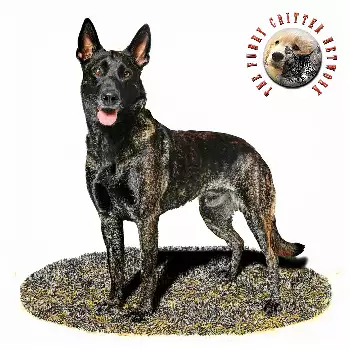The Hollandse Herdershond enjoys relatively good health compared to many purebred dogs, benefiting from its working heritage where functionality and soundness were prioritized over purely cosmetic traits. The breed's development as a landrace variety and subsequent careful breeding practices have helped maintain genetic diversity and reduce the incidence of severe hereditary conditions. However, like all breeds, they are susceptible to certain health issues that responsible breeding and proper health screening can help minimize.
The breed's overall constitution reflects its hardy working background, with most individuals demonstrating good longevity and maintaining active lifestyles well into their senior years. Their athletic build and natural activity levels contribute to cardiovascular health and muscle tone throughout life, though proper exercise management during growth and aging periods is important for preventing injury and maintaining optimal condition.
Health screening within the breed community has improved significantly since the establishment of organized health monitoring programs, including the health hotline initiated by the Nederlandse Herdershonden Club in 2008. This collaborative approach to health data collection has provided valuable insights into breed-specific concerns and helped guide breeding decisions to improve overall health outcomes.
The relatively small global population of the Hollandse Herdershond requires careful attention to genetic diversity in breeding programs. Responsible breeders work to maintain healthy breeding lines while avoiding the concentration of deleterious genes that can occur in numerically limited breeds. International cooperation between breeding communities helps maintain genetic diversity across different geographical regions.
Common Health Issues
- Hip Dysplasia: Joint malformation affecting approximately 9% of the breed population according to OFA statistics. This condition can range from mild to severe and may cause lameness or arthritis. All breeding dogs should receive hip evaluations through OFA or PennHIP screening.
- Elbow Dysplasia: Developmental condition affecting the elbow joint with a prevalence of about 5.5% in the breed. Can cause lameness and arthritis if severe. Early detection through radiographic screening allows for appropriate management and breeding decisions.
- Inflammatory Myopathy: Recently identified genetic condition causing progressive muscle inflammation and weakness, typically manifesting between 3-8 months of age. DNA testing through University of Minnesota allows identification of carriers and prevention of affected offspring.
Recommended Health Testing
- Hip and Elbow Radiographs: OFA or PennHIP evaluations to assess joint development and screen for dysplastic changes. Essential for all breeding candidates and valuable for pet owners planning activity levels.
- Ophthalmologic Examinations: Annual eye exams by board-certified veterinary ophthalmologists to screen for hereditary eye conditions including pannus, goniodysplasia, and other inherited disorders.
- Inflammatory Myopathy DNA Test: Genetic screening through University of Minnesota Canine Genetics Laboratory to identify carriers and prevent producing affected puppies in breeding programs.
Goniodysplasia represents a particular concern in the rough-haired variety, where impaired drainage of fluid from the eye can potentially lead to vision problems. The genetic basis of this condition is not fully understood, making clinical screening important for breeding decisions. Regular ophthalmologic examinations can detect early signs and allow for appropriate treatment when necessary.
Allergic conditions, including environmental and food allergies, can affect some individuals within the breed. These typically manifest as skin irritation, itching, or digestive issues and require identification of triggers and appropriate management strategies. While not life-threatening, allergies can significantly impact quality of life and require ongoing veterinary care.
Pannus, also known as chronic superficial keratitis, is an inflammatory eye condition that has been documented in the breed. This condition appears to have both genetic and environmental components, with increased severity at higher altitudes and greater ultraviolet exposure. While requiring lifelong medication, affected dogs can typically maintain good vision and quality of life with proper treatment.
Masticatory myositis, an autoimmune condition affecting the muscles used for chewing, has been confirmed in some Hollandse Herdershonds. Early recognition and treatment are important for managing this condition effectively and preventing permanent muscle damage. The condition typically responds well to appropriate immunosuppressive therapy when caught early.
Cryptorchidism, where one or both testicles fail to descend properly, occurs occasionally in the breed and is considered hereditary. While not affecting the dog's health or quality of life significantly, affected males should not be used for breeding to prevent perpetuation of this trait.
Digestive issues, including inflammatory bowel disease, have been identified in some breed members. These conditions typically require dietary management and sometimes medication but usually allow affected dogs to live comfortable, normal lives when properly managed.
The breed's high activity levels and working drive make adequate exercise essential for both physical and mental health. Insufficient exercise can lead to behavioral problems, obesity, and associated health complications. Conversely, appropriate exercise levels help maintain cardiovascular fitness, muscle tone, and joint flexibility throughout life.
Nutritional requirements for the Hollandse Herdershond should reflect their active lifestyle and working heritage. High-quality nutrition supports their energy needs while appropriate mineral balance during growth helps ensure proper skeletal development. Working dogs may require adjusted nutrition during periods of intense training or activity.
Mental health considerations are equally important for this intelligent breed. Boredom, lack of purpose, or insufficient mental stimulation can lead to stress-related behaviors and potentially impact physical health. Providing appropriate mental challenges through training, work, or interactive activities contributes significantly to overall well-being.
Regular veterinary care, including appropriate vaccinations, parasite prevention, and dental maintenance, forms the foundation of good health management for the breed. Early detection of potential issues through routine examinations allows for prompt intervention and better outcomes in most cases.

